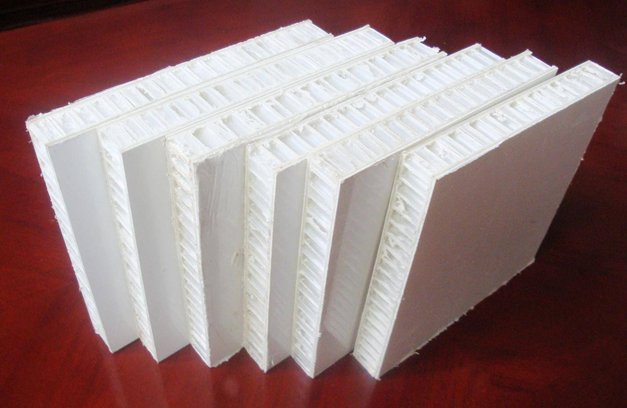
Plastic honeycomb panels have many characteristics that conventional materials do not have, mainly in the following aspects:

(1) Lightweight and low density: The core layer of the honeycomb panel is a typical porous structure, and the continuous polygonal cells are arranged regularly and periodically. Therefore, the cross-sectional area of the solid part of the honeycomb panel is tiny, so its density is compared with other sandwich materials. It's also small.
Since the density of honeycomb panels is much smaller than that of ordinary boards such as laminates and plywood, its mass is also the lightest when the volume is the same. This allows plastic honeycomb panels to save energy in transportation applications. Low-density and lightweight honeycomb panels will meet the requirements of "lightweight, energy-saving and environmentally friendly" materials for marine transportation projects and transportation tools.

(2) High specific strength and good rigidity: From a mechanical perspective, the honeycomb panel structure is similar to many I-beams connected to each other. The panel is identical to the flange of the I-beam, which mainly bears in-plane loads. The honeycomb core is similar to the web of an I-beam. Its main function is to withstand shear stress and connect and support the upper and lower panel members. However, the honeycomb core is different from the web of an I-beam. It is not sparsely reinforced but densely reinforced. The core layer is distributed and fixed throughout the board surface, and the core layer height is much larger than the panel thickness, which makes the cross-sectional moment of inertia also Increase exponentially while improving the overall stiffness, and the overall stability also increases significantly.
(3) Good impact resistance, vibration damping and cushioning properties. When the honeycomb panel is subjected to out-of-plane impact, it can convert the impact force into the plastic deformation energy of the honeycomb core, so it can effectively absorb the impact energy. By conducting a self-falling ball impact experiment on the plastic honeycomb panel, we observed the dented area and dent depth at the impact site and found that there were no cracks at the impact site, indicating that the plastic honeycomb panel has good toughness and strong impact resistance, and can absorb large amounts of damage through its deformation. Partial energy, good vibration reduction effect.

(4) Thermal and sound insulation. The material used to make the honeycomb panel itself has no heat and sound insulation properties, but the unique structure of the honeycomb panel makes the honeycomb panel have good heat and sound insulation properties. The core is a porous structure, and the cells occupy most of the space. Take a plastic honeycomb panel with a specification of 50*50*12mm made of a plastic pipe with a wall thickness of 0.1mm as an example. The solid part only accounts for the total volume. 4%. After the honeycomb core and the panel are combined into a honeycomb panel, the cells become a cylindrical closed space, and the air layer between the upper and lower panels is also divided into many closed cells, preventing the air from flowing and making it difficult for heat to pass through in the form of convection and radiation. In this structure, the propagation of sound waves is also greatly restricted, so honeycomb panels have better heat insulation and sound insulation properties.
(5) Good fireproof and moisture-proof properties. The panel and core layer of the honeycomb panel are composited. The core layer can play a very good flame retardant and fireproof role after being composited with the HPL fireproof board. In addition, the plastic honeycomb core itself has good chemical stability, corrosion resistance and moisture resistance.

(6) Good formability, optional thickness. The thickness of the plastic honeycomb panel can be selected from 5-500mm according to actual needs, and the shape can also be made into a flat panel, single-curved panel or double-curved panel according to specific requirements.
(7) No pollution, energy saving and environmental protection. Polypropylene is the material used to prepare plastic honeycomb panels. It is neither radioactive nor volatilizes any harmful gases that are harmful to human health. It can also be completely recycled and reused, saving resources and energy, and is very consistent with the requirements of energy conservation and environmental protection. In addition, honeycomb panels reduce the mass of vehicles, improve power while ensuring strength, reduce fuel consumption, save energy and reduce exhaust pollution.
(8) Beautiful and easy to clean. The surface can be coated with different covering layers in various colours or patterns.

